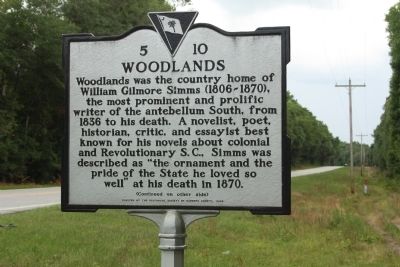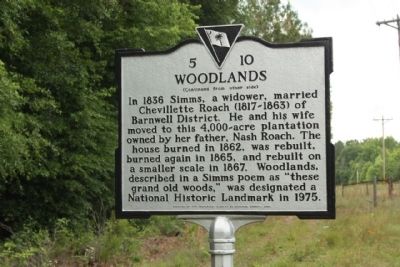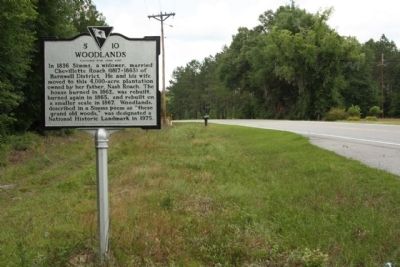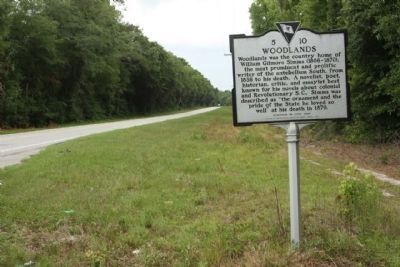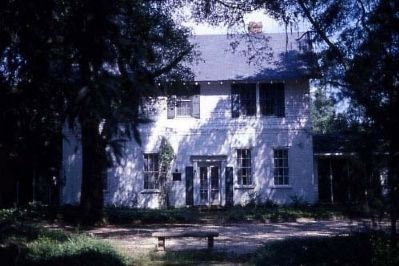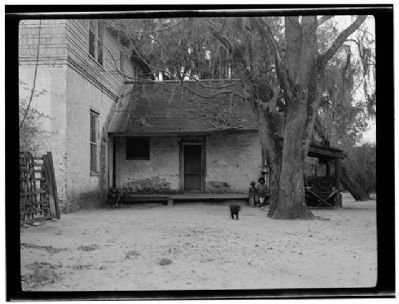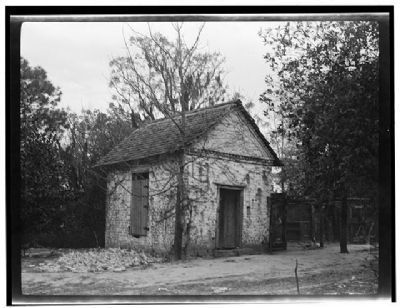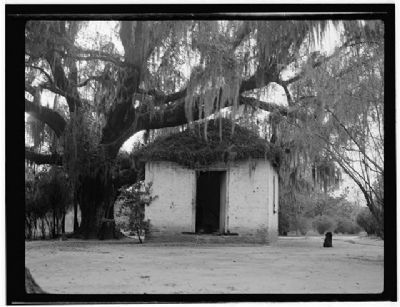Bamberg in Bamberg County, South Carolina — The American South (South Atlantic)
Woodlands
Woodlands was the country home of William Gilmore Simms (1806-1870), the most prominent and prolific writer of the antebellum South, from 1836 to his death. A novelist, poet, historian, critic, and essayist best known for his novels about colonial and Revolutionary S.C., Simms was described as “the ornament and the pride of the State he loved so well” at his death in 1870.
(Reverse text)
In 1836 Simms, a widower, married Chevillette Roach (1817-1863) of Barnwell District. He and his wife moved to this 4,000-acre plantation owned by her father, Nash Roach. The house burned in 1862, was rebuilt, burned again in 1865, and rebuilt on a smaller scale in 1867. Woodlands, described in a Simms poem as “these grand old woods,” was designated a National Historic Landmark in 1975.
Erected 2005 by The Historical Society of Bamberg County. (Marker Number 5-10.)
Topics and series. This historical marker is listed in these topic lists: Arts, Letters, Music • Colonial Era • Settlements & Settlers • War, US Revolutionary. In addition, it is included in the National Historic Landmarks series list. A significant historical year for this entry is 1836.
Location. 33° 16.349′ N, 80° 57.625′ W. Marker is in Bamberg, South Carolina, in Bamberg County. Marker is on Heritage Highway (U.S. 78), on the left when traveling west. Located between Wray's Road and Dot's Court. Touch for map. Marker is in this post office area: Bamberg SC 29003, United States of America. Touch for directions.
Other nearby markers. At least 8 other markers are within 9 miles of this marker, measured as the crow flies. Carlisle Military School (approx. 4.4 miles away); Bamberg (approx. 4˝ miles away); Bamberg County Confederate Monument (approx. 4.6 miles away); Bamberg County Courthouse (approx. 4.6 miles away); Pinewood Plantation (approx. 7.8 miles away); South Carolina Canal & Rail Road Company (approx. 8˝ miles away); Branchville Depot (approx. 8˝ miles away); Orangeburg County (approx. 8˝ miles away). Touch for a list and map of all markers in Bamberg.
Regarding Woodlands. A significant literary landmark, Woodlands was the country estate home of William Gilmore Simms, son-in-law of Nash Roach, a gentleman of English descent and wealthy owner of several plantations. In 1836, Simms, noted Southern author, married Roach’s daughter, Chevilette Eliza, and was given Woodlands Plantation. Simms said in his letters, about 1836-1857, “I am moving into an ancient dwelling largely fallen into disrepair.” In 1859, Simms began enlargement of the house, adding a library and nursery wings, which considerably increased the impressiveness of the residence. In 1862, the original house burned except for the library wing. The second house, including much of Simms’ extensive personal library, was burned in 1865 by stragglers of the Federal army. In 1868, Simms once again endeavored to “render Woodlands habitable.” The present house retains the windows and most of the woodwork Simms assembled in Charleston, where he had a town house. There were also twelve outbuildings that stood at in a semi-circle at the back of the house, two remain, although the foundations of all have been located. One became Simms’ study. As a result of Simms’ literary prominence, Woodlands became a center of literary activity where such distinguished visitors as William Cullen Bryant, G. P. R. James, John R. Thompson, Paul Hayne, James Lawson, and Henry Timrod were frequently received. Listed in the National Register November 11, 1971; Designated as a National Historic Landmark November 11, 1971. (South Carolina Department of Archives and History)
Also see . . . William Gilmore Simms, From Wikipedia. William Gilmore Simms (April 17, 1806 – June 11, 1870) was a poet, novelist and historian from the American South whose novels achieved great prominence during the 19th century, with Edgar Allan Poe pronouncing him the best novelist America had ever produced... (Submitted on June 19, 2010, by Mike Stroud of Bluffton, South Carolina.)
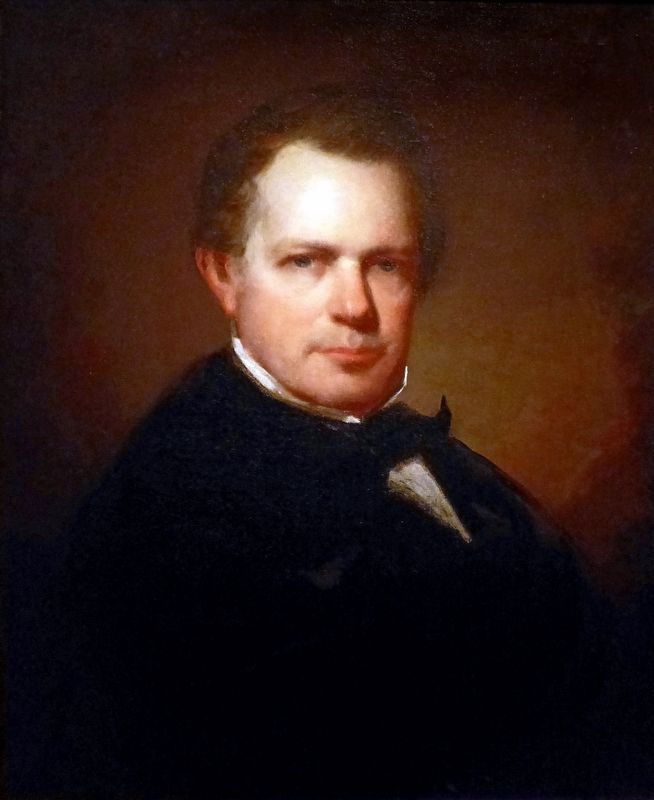
Photographed By Allen C. Browne, July 25, 2017
9. William Gilmore Simms
This undated portrait of William Gilmore Simms by an unknown artist hangs in the National Portrait Gallery in Washington, DC.
"Novelist and poet William Gilmore Simms was a founder of a distinctly southern literary perspective, one that is influential in history and literature to this day. Simms spent his life writing, turning out a series of colorful novels as well as a substantial body of verse. He invested his fiction with local color and details of southern history, especially from the Revolutionary War period. Like Washington Irving, he adapted the style of Sir Walter Scott's historical novels to American narratives. Simms's writings were a conscious defense of southern civilization (including slavery) as humane, patriotic, and chivalric, especially in contrast to the cold capitalism of the North. This contrast, minus the defense of slavery, remains a staple of southern writing." -- National Portrait Gallery
"Novelist and poet William Gilmore Simms was a founder of a distinctly southern literary perspective, one that is influential in history and literature to this day. Simms spent his life writing, turning out a series of colorful novels as well as a substantial body of verse. He invested his fiction with local color and details of southern history, especially from the Revolutionary War period. Like Washington Irving, he adapted the style of Sir Walter Scott's historical novels to American narratives. Simms's writings were a conscious defense of southern civilization (including slavery) as humane, patriotic, and chivalric, especially in contrast to the cold capitalism of the North. This contrast, minus the defense of slavery, remains a staple of southern writing." -- National Portrait Gallery
Credits. This page was last revised on December 11, 2019. It was originally submitted on June 19, 2010, by Mike Stroud of Bluffton, South Carolina. This page has been viewed 1,670 times since then and 64 times this year. Photos: 1, 2, 3, 4, 5. submitted on June 19, 2010, by Mike Stroud of Bluffton, South Carolina. 6, 7, 8. submitted on June 19, 2010, by Michael Sean Nix of Spartanburg, South Carolina. 9. submitted on November 29, 2017, by Allen C. Browne of Silver Spring, Maryland.
